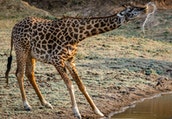- 1. Africa Mandrill Appearance: Mandrills are one of the most colorful primates. Adult males are more vibrant than females and have strikingly colorful faces with blue and red ridges on their noses, colorful cheeks, and yellow beards. They also have a bright red and blue rump. Females and juveniles have less colorful markings.
- 2. Africa Mandrill Size: Mandrills are the largest of all monkey species. Adult males can weigh between 50 to 90 pounds (23 to 41 kilograms) and have a body length of about 30 to 35 inches (76 to 89 centimeters), excluding their tails.
- 3. Africa Mandrill Social Structure: Mandrills live in large social groups known as troops. A typical troop consists of several females and their offspring, led by a dominant male. These groups can be quite large, with up to several hundred individuals.
- 4. Africa Mandrill Habitat: Mandrills primarily inhabit dense rainforests and swampy areas in central and western Africa, including countries such as Cameroon, Gabon, and the Congo.
- 5. Africa Mandrill Diet: Mandrills are omnivores and have a varied diet. They primarily feed on fruits, seeds, leaves, and other plant material. Additionally, they also consume insects, small vertebrates, and even bird eggs.
- 6. Africa Mandrill Behavior: Mandrills are diurnal animals, meaning they are active during the day. They spend much of their time on the ground but are skilled climbers and occasionally go into the trees to search for food.
- 7. Africa Mandrill Communication Mandrills communicate using vocalizations, facial expressions, and body postures. They have a range of calls to signal various messages to their troop members. Conservation Status: The mandrill is classified as "Vulnerable" by the International Union for Conservation of Nature (IUCN) due to habitat loss and hunting for bushmeat.
- 8. Africa Mandrill Conservation Status: The mandrill is classified as "Vulnerable" by the International Union for Conservation of Nature (IUCN) due to habitat loss and hunting for bushmeat.
Africa Mandrill
The mandrill (Mandrillus sphinx) is a fascinating primate native to the rainforests of central and western Africa.
Africa Safari Tour Book online The Mandrill safari
Here is some information about the mandrill:
Africa Mandrill Safari Tour
An Africa safari with a focus on observing mandrills offers a unique and thrilling opportunity to witness these colorful and fascinating primates in their natural rainforest habitat. Spotting mandrills in the wild can be a rare and thrilling experience due to their elusive nature and the dense rainforest environments they inhabit.
By planning ahead and choosing reputable safari operators or guides, you can have an unforgettable Mandrill-focused safari and create lasting memories of witnessing these magnificent big cats in their natural African environment. Remember that observing wildlife in their natural habitats requires patience and respect for the animals and their surroundings.
Here are some key points to consider when planning a mandrill-focused safari:
Africa Mandrills Safari Destinations
Safari Destinations: Mandrills are primarily found in the dense rainforests of central and western Africa. Some popular safari destinations known for their mandrill populations include:
- Gabon: Lopé National Park, Ivindo National Park, Loango National Park.
- Republic of the Congo: Odzala-Kokoua National Park, Nouabalé-Ndoki National Park.
- Cameroon: Dja Faunal Reserve, Campo Ma'an National Park.
Africa Mandrill Guided Rainforest Walks:
Guided Rainforest Walks: Participate in guided rainforest walks or treks with experienced guides to explore the habitats where mandrills are commonly found. Walking safaris provide a more intimate and immersive experience with the wildlife and the lush rainforest environment.
Africa Mandrill Rainforest Experience:
Rainforest Experience: Apart from mandrills, the rainforests of central and western Africa offer a unique experience with their lush greenery, diverse plant life, and other wildlife. Take the time to appreciate the beauty and complexity of these biodiverse ecosystems.
Africa Mandrill Expert Guides:
Expert Guides: Engage experienced safari guides who are knowledgeable about mandrill behavior and habitats. They can help track and locate these elusive primates, increasing your chances of successful sightings.
Africa Mandrill Accommodations
Choose accommodations located near the water bodies where Mandrill are commonly found. Many lodges and camps offer opportunities for boat safaris or have waterholes frequented by Mandrill.
Africa Mandrill Photography Opportunities
Photography Opportunities: Bring a good camera with a zoom lens to capture mandrill sightings and other wildlife in their natural habitats. A pair of binoculars will also be useful for better wildlife viewing.
Africa Mandrill Wildlife Diversity:
Wildlife Diversity: While on your mandrill safari, you'll likely encounter a diverse range of African wildlife, including other primate species, birdlife, and various forest-dwelling animals.
Africa Mandrill Conservation and Responsible Tourism:
Conservation and Responsible Tourism: Practice responsible wildlife viewing by following park regulations and respecting the natural behavior of mandrills and other animals. Support conservation efforts that aim to protect the rainforest habitats and populations of these colorful primates.








 |
|  |
|  |
|  |
| 